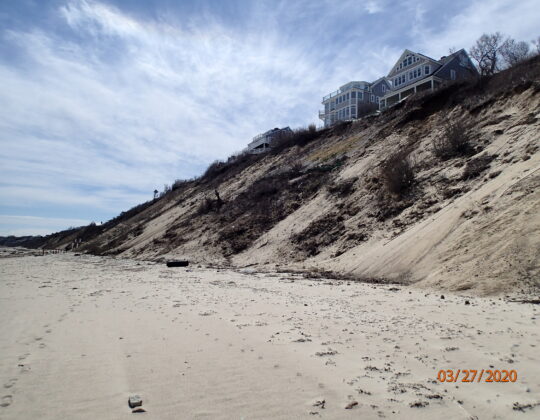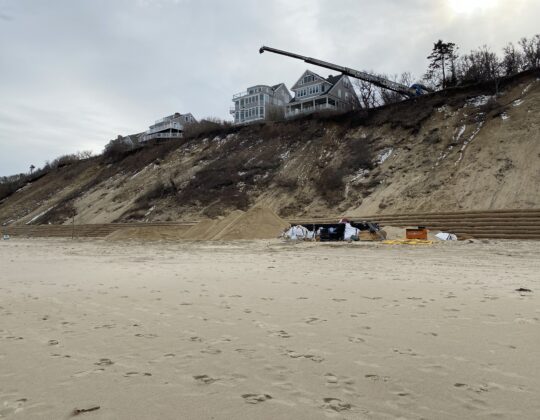Innovative Land Access and Coastal Erosion Solutions Lead to Extraordinary Results
August 15th, 2023

Seven private homeowners in a southeastern Massachusetts coastal community had a big problem on their hands. Their adjoining properties were located atop a rapidly eroding coastal bank stripped of its vegetation covering, on land not owned by them but rather by the Town. The installation of any bank stabilization system to protect their properties from accelerated bank erosion would therefore need to be located on town-owned land, approved by both the conservation commission and board of selectmen. It was a dire and challenging situation, to say the least.
Prior attempts to stabilize the bank had failed due to the continued scour at the toe of the slope typically occurring during coastal storms. As the toe of the slope eroded, the vegetated areas above became unsupported, and in the most severely scoured parts of the bank these vegetated areas sheared away and began their descent down the face of the slope. This resulted in additional denuded areas on the face of the bank.
By 2020, most of the coastal bank had become stripped of its vegetation, making it extremely vulnerable to erosion from storms as well as other less violent forces such as wind, precipitation, and overland runoff. To make matters worse, the slope of the coastal bank had approached the soil’s natural angle of repose, so that the potential for severe erosion was raised to an even higher level. Under these conditions, even a modest breeze or gentle rain sent bank sediments tumbling toward the beach. In short, the rate of erosion had accelerated to a point where it was engulfing private property and threatening vulnerable residences.
The goal of this project has been to reduce the rate of erosion by controlling the scour along the toe of the coastal bank so that the denuded areas above could be stabilized and replanted. It was assumed that a densely vegetated bank would help decrease erosion, while periodic sand placement at the toe of the bank would provide sufficient nourishment to the beach to compensate for sand that was naturally eroding off the slope.

It was thought that these measures would provide a reasonable level of protection to the impacted homeowners by controlling erosion at the base while maintaining the amount of sand contributed to the beach from the lower portion of the bank under pre-stabilization conditions.
Through a coordinated consulting and permitting effort, Epsilon Associates was able to help the landowners and town conservation commission reach an agreement that enabled the homeowners to protect their properties. A “revocable” license was established enabling installation of a sophisticated soft armoring system on the town-owned land, with operations tightly controlled by the conditions of the permit issued by the Conservation Commission and the terms of the license from the Town. The installed bank stabilization system is not in conflict with the Conservation Commission’s mission and management of the open space parcel and is consistent with and enhances the use of the town’s property for open space and passive recreational use.
Epsilon met with the affected homeowners to discuss a variety of bank stabilization strategies; compared alternatives on the basis of longevity and cost; held a series of meetings with the conservation commission and the Town to present the preferred alternative; prepared permitting documents, and assisted the owner's attorney in developing the license agreement. Epsilon also prepared the construction compliance report documenting both the installer’s work, and the success of the project.

Epsilon offers a host of coastal and marine services to public and private clients. View our coastal and marine services, here.
About the expert:
Jack Vaccaro; Senior Consultant, Coastal and Marine Group

Jack Vaccaro is a Senior Consultant in the Coastal and Marine Group at Epsilon Associates, Inc. He has over 30 years of experience in wetland ecology and permitting of energy transmission and communications infrastructure projects on land and sea, around the world. He also has extensive experience with permitting residential and commercial real estate developments throughout southeastern Massachusetts, with an emphasis on projects located along the coast.